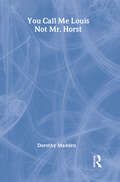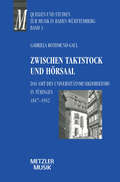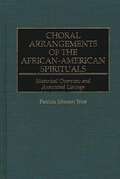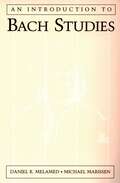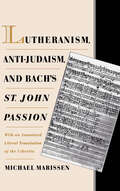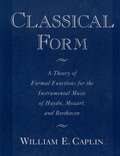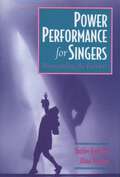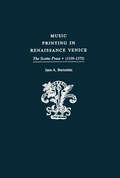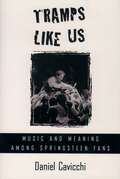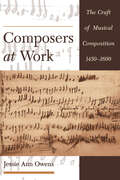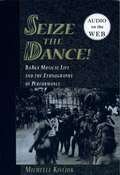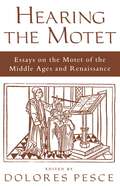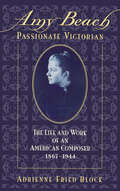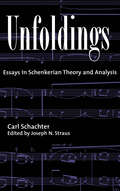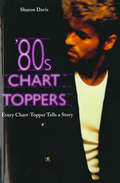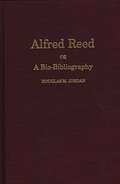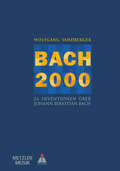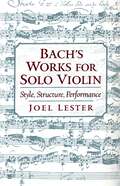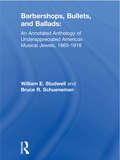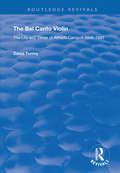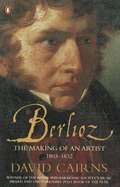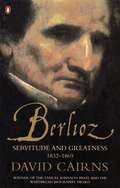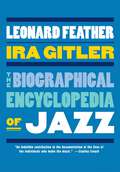- Table View
- List View
You Call Me Louis, Not Mr. Horst
by Dorothy MaddenDorothy Madden's lively book about Louis Horst (You don't call me Mr. Horst, you call me Louis, he always said) makes for compulsive reading. She follows Horst's extraordinary life, punctuating her narrative with reminiscences, illuminating anecdotes from her personal store of memories, as well as the shared thoughts of others, all interspersed with her choice of evocative and expressive photographs and illustrations, to create a dynamic and memorable portrait of this key figure in American modern dance. Louis Horst: musician, composer, pianist, violonist, pit player, arranger, super accompanist (all sorts), conductor, régisseur, stage manager, tour tartar, catalyst, editor, writer, critic, teacher, consoler, the Sherlock Holmes of restaurants, keeper of journals and budgets, loan provider, lover, friend...
Zwischen Taktstock und Hörsaal: Das Amt des Universitätsmusikdirektos in Tübingen 1817-1952
by Gabriela Rothmund-GaulIm traditionellen Fächerkanon der Tübinger Alma Mater war er nicht vorgesehen: der Universitätsmusikdirektor. Doch schon der erste akademische Musiklehrer Friedrich Silcher gestaltete in über 40 Dienstjahren seine Stelle zu einem mit Ansehen und vielfältigsten Pflichten versehenen Amt, das von der Hochschule und aus der Stadt nicht mehr wegzudenken war. Schon bei ihm wurde die der Stelle immanente Polarität deutlich - die Tätigkeit als Praktiker und als Theoretiker -, die erst 1952 zur Trennung von Praxis und Wissenschaft und zur Errichtung eines Lehrstuhls für Musikwissenschaft führte. Auf der Basis ausgiebiger Quellenstudien stellt Rothmund-Gaul unter dem institutionsgeschichtlichen Ansatz das Werden des Faches Musikwissenschaft - exemplifiziert an der Universität Tübingen - dar. Daß unter den Bewerbern viele berühmte Musikwissenschaftler wie Musiker waren, zeigt einerseits, welche Anziehungskraft das Amt eines Universitätsmusikdirektors hatte, und macht andererseits deutlich, wie sehr musikalische Praxis und musikwissenschaftliches Arbeiten noch bis in die Mitte unseres Jahrhunderts verbunden waren.
Choral Arrangements of the African-American Spirituals: Historical Overview and Annotated Listings (Music Reference Collection)
by Patricia J. TriceAlthough the choral arrangements of the African-American spirituals constitute the largest group of folk song arrangements in western literature, they have received little scholarly attention. This book provides the needed historical and stylistic information about the spirituals and the arrangements. It traces the history and cultural roots of the genre through its inception and delineates the African and European characteristics common to the original folk songs and arrangements. Ensembles that have perpetuated the growth of the spiritual arrangements—from Fisk Jubilee Singers of the 1870s through those currently active—are chronicled as well.Musicians, choral directors, and scholars will welcome this first complete text on the African-American spiritual genre. Annotated listings of titles provide information choral directors need to make ensemble-appropriate performance choices. Arrangements indexed by title, arranger, and subject complement the accompanying biographies and repertoire information. Well-organized and thoroughly researched, this text is a valuable addition to music, choral, multicultural, and African-American libraries.
An Introduction to Bach Studies
by Daniel R. Melamed Michael MarissenThis volume is a guide to the resources and materials of Bach scholarship, both for the non specialist wondering where to begin in the enormous literature on J. S. Bach, and for the Bach specialist looking for a convenient and up to date survey of the field. It describes the tools of Bach research and how to use them, and suggests how to get started in Bach research by describing the principal areas of research and citing the essential literature on each piece and topic. The authors emphasize the issues that have engaged Bach scholars for generations, focusing on particularly important writings; on recent literature; on overviews, collections of essays and handbooks; and on writings in English. Subjects covered include bibliographic tools of Bach research and sources of literature; Bach's family; Bach biographies; places Bach lived and worked; Bach's teaching; the liturgy; Bach source studies and the transmission of his music; repertory and editions; genres and individual vocal and instrumental works; performance practice; the reception and analysis of Bach's music; and many others. The book also offers explanations of important and potentially confusing topics in Bach research, such as the organization of the annual cantata cycles, pitch standards, the history of the Berlin libraries, the structure of the critical commentary volumes in the Neue Bach Ausgabe, and so on. This book opens up the rich world of Bach scholarship to students, teachers, performers, and listeners.
Lutheranism, Anti-Judaism, and Bach's St. John Passion: With an Annotated Literal Translation of the Libretto
by Michael MarissenBach's St. John Passion is surely one of the monuments of Western music, yet performances of it are inevitably controversial. In large part, this is because of the combination of the powerful and highly emotional music and a text that includes passages from a gospel marked by vehement anti-Judaic sentiments. What did this masterpiece mean in Bach's day and what does it mean today? Although bibliographies on Bach and Judaism have grown enormously since World War II, there has been very little work on the relationship between the two areas. This is hardly surprising; Judaica scholars and culture critics focusing on issues of anti-Semitism commonly lack musical training and are, in any event, quite reasonably interested in even more pressing social and political issues. Bach scholars, on the other hand, have mostly concentrated on narrowly defined musical topics. Strangely, therefore, almost no scholarly attention has been given to relationships between Lutheranism and the religion of Judaism as they affect Bach's most controversial work, the St. John Passion. Through a reappraisal of Bach's work and its contexts, Marissen confronts Bach and Judaism directly, providing interpretive commentary that could serve as a basis for a more informed and sensitive discussion of this troubling work. Consisting of a long interpretive essay, followed by an annotated literal translation of the libretto, a guide to recorded examples, and a detailed bibliography, this concise text provides the reader with the tools to assess the work on its own terms and in the appropriate context.
Classical Form: A Theory of Formal Functions for the Instrumental Music of Haydn, Mozart, and Beethoven
by William E. CaplinBuilding on ideas first advanced by Arnold Schoenberg and later developed by Erwin Ratz, this book introduces a new theory of form for instrumental music in the classical style. The theory provides a broad set of principles and a comprehensive methodology for the analysis of classical form, from individual ideas, phrases, and themes to the large-scale organization of complete movements. It emphasizes the notion of formal function, that is, the specific role a given formal unit plays in the structural organization of a classical work.
Power Performance for Singers: Transcending the Barriers
by Shirlee Emmons Alma ThomasTo perform well in today's highly competitive world where technical skills have been advanced to an unprecedented degree, a singer must be able to handle incredible pressure within the performing arena; his or her ability to deal with this stress will often determine whether he or she will succeed. Why, then, do singers with less technical skill sometimes out-perform stars? Why do some stars suddenly stop performing? What is that mysterious factor that makes an electric performance? Consistent, competent performances do not depend solely upon superior vocal skills, nor are they a matter of luck. On the contrary, the best performances result from a combination of mental attitude, concrete performing skills, and excellent technical skills in that order. Yet most singers have never had the opportunity to acquire the essential skills that make for a successful career. Written as a self-help manual for singers at all levels of expertise, Power Performance for Singers is designed to teach performing artists, and especially singers, how to experience elite performance at their level. The skills outlined in this book will help singers use what they have, to enjoy their voices during performance, and to perform consistently to the best of their present ability.
Music Printing in Renaissance Venice: The Scotto Press (1539-1572)
by Jane A. BernsteinVenetian music print culture of the mid-sixteenth century is presented here through a study of the Scotto press, one of the foremost dynastic music publishers of the Renaissance. For over a century, the house of Scotto played a pivotal role in the international book trade, publishing in a variety of fields including philosophy, medicine, religion, and music. This book examines the mercantile activities of the firm through both a historical study, which illuminates the wide world of the Venetian music printing industry, and a catalog, which details the music editions brought out by the firm during its most productive period. A valuable reference work, this book not only enhances our understanding of the socioeconomic and cultural history of Renaissance Venice, it also helps to preserve our knowledge of a vast musical repertory.
Tramps Like Us: Music and Meaning among Springsteen Fans
by Daniel CavicchiAs rock critics have noted in the past, Bruce Springsteen's songs exist in a world of their own--they have their own settings, characters, words, and images. It is a world that even those who know only a handful of Springsteen's lyrics can instantly recognize, a world of highways and factories, loners and underdogs, hot rods and patrol cars. And it is a world that stretches far beyond the New Jersey state line. Indeed, Springsteen's attention to the ideals and struggles of ordinary Americans has significantly influenced American popular culture and public debate. As a rock-and-roll troubadour, "the Boss" speaks not only for his many fans but to them, and often with a directness or sincerity that no other performer can match. But what can be said of the fans themselves? Why and how do they relate to Springsteen's words and music? Based on three years of ethnographic research amid Springsteen's fans, and informed by the author's own experiences and impressions as a fan, Daniel Cavicchi's Tramps Like Us is an interdisciplinary study of the ways in which ordinary people form special, sustained attachments to a particular singer/songwriter and his songs, and of how these attachments function in people's lives. An "insider's narrative" about Springsteen fans--who they are, what they do, and why they do it--this book also investigates the phenomenon of fandom in general. The text oscillates between fans' stories and ideas and Cavicchi's own anecdotes, commentary, and analysis. It challenges the stereotypes of fans as obsessive, delusional, and even mentally ill, and explores fandom as a normal socio-cultural activity. Ultimately, this book argues that music fandom is a useful and meaningful behavior that enables us to shape identities, create communities, and make sense of the world--both Bruce's and our own.
Composers at Work: The Craft of Musical Composition 1450-1600
by Jessie Ann OwensHow did Renaissance composers write their music? In this revolutionary look at a subject that has fascinated scholars for years, musicologist Jessie Ann Owens offers new and striking evidence that contrary to accepted theory, sixteenth-century composers did not use scores to compose--even to write complex vocal polyphony. Drawing on sources that include contemporary theoretical treatises, documents and letters, iconographical evidence, actual fragments of composing slates, and numerous sketches, drafts, and corrected autograph manuscripts, Owens carefully reconstructs the step-by-step process by which composers between 1450 and 1600 composed their music. The manuscript evidence--autographs of more than thirty composers--shows the stages of work on a wide variety of music--instrumental and vocal, sacred and secular--from across most of Renaissance Europe. Her research demonstrates that instead of working in full score, Renaissance composers fashioned the music in parts, often working with brief segments, according to a linear conception. The importance of this discovery on editorial interpretation and on performance cannot be overstated. The book opens with a broad picture of what has been known about Renaissance composition. From there, Owens examines the teaching of composition and the ways in which musicians and composers both read and wrote music. She also considers evidence for composition that occurred independent of writing, such as composing "in the mind" or composing with instruments. In chapters on the manuscript evidence, she establishes a typology both of the sources themselves and of their contents (sketches, drafts, fair copies). She concludes with case studies detailing the working methods of Francesco Corteccia, Henricus Isaac, Cipriano de Rore, and Giovanni Pierluigi da Palestrina. This book will change the way we analyze and understand early music. Clear, provocative, and painstakingly researched, Composers at Work: The Craft of Musical Composition 1450-1600 makes essential reading for scholars of Renaissance music as well as those working in related fields such as sketch studies and music theory.
Seize the Dance!: BaAka Musical Life and the Ethnography of Performance
by Michelle Kisliuk"Pygmy music" has captivated students and scholars of anthropology and music for decades if not centuries, but until now this aspect of their culture has never been described in a work that is at once vividly engaging, intellectually rigorous, and self-consciously aware of the ironies of representation. Seize the Dance! is an ethnomusical study focused on the music and dance of BaAka forest people, who live in the Lobaye region of the Central African Republic. Based on ethnographic research that Michelle Kisliuk conducted from 1986 through 1995, this book describes BaAka songs, drum rhythms, and dance movements--along with their contexts of social interaction--in an elegant narrative that is enhanced by many photographs, musical illustrations, and field recordings on two compact discs.
Hearing the Motet: Essays on the Motet of the Middle Ages and Renaissance
by Dolores PesceThe motet was unquestionably one of the most important vocal genres from its inception in late twelfth-century Paris through the Counter-Reformation and beyond. Heard in both sacred and secular contexts, the motet of the Middle Ages and Renaissance incorporated a striking wealth of meaning, its verbal textures dense with literary, social, philosophic, and religious reference. In Hearing the Motet, top scholars in the field provide the fullest picture yet of the motet's "music-poetic" nature, investigating the virtuosic interplay of music and text that distinguished some of the genre's finest work and reading individual motets and motet repertories in ways that illuminate their historical and cultural backgrounds. How were motets heard in their own time? Did the same motet mean different things to different audiences? To explore these questions, the contributors go beyond traditional musicological methods, at times invoking approaches used in recent literary criticism. Providing as well a cutting-edge look at performance questions and works by composers such as Josquin, Willaert, Obrecht, Byrd, and Palestrina, the book draws a valuable new portrait of the motet composer. Here, intriguingly, the motet composer emerges as a "reader" of the surrounding culture--a musician who knew liturgical practice as well as biblical literature and its exegetical traditions, who moved in social contexts such as humanist gatherings, who understood numerical symbolism and classical allusion, who wrote subtle memorie for patrons, and who found musical models to emulate and distort. Fresh, broad-ranging, and unique, Hearing the Motet makes vital reading for scholars, performers, and students of medieval and Renaissance music, and anyone else with an interest in the musical culture of these periods. Contributors include Rebecca A. Baltzer, Margaret Bent, M. Jennifer Bloxam, David Crook, James Haar, Paula Higgins, Joseph Kerman, Patrick Macey, Craig Monson, Robert Nosow, Jessie Ann Owens, Dolores Pesce, Joshua Rifkin, Anne Walters Robertson, Richard Sherr, and Rob C. Wegman.
Amy Beach, Passionate Victorian: The Life and Work of an American Composer, 1867-1944
by Adrienne Fried BlockAmy Marcy Cheney Beach (1867-1944), the most widely performed composer of her generation, was the first American woman to succeed as a creator of large-scale art music. Her "Gaelic" Symphony, given its premiere by the Boston Symphony Orchestra in 1896, was the first work of its kind by an American woman to be performed by an American orchestra. Almost all of her more than 300 works were published soon after they were composed and performed, and today her music is finding new advocates and audiences for its energy, intensity, and sheer beauty. Yet, until now, no full-length critical biography of Beach's life or comprehensive critical overview of her music existed. This biography admirably fills that gap, fully examining the connections between Beach's life and work in light of social currents and dominant ideologies. Born into a musical family in Victorian times, Amy Beach started composing as a child of four and was equally gifted as a pianist. Her talent was recognized early by Boston's leading musicians, who gave her unqualified support. Although Beach believed that the life of a professional musician was the only life for her, her parents had raised her for marriage and a career of amateur music-making. Her response to this parental (and later spousal) opposition was to find creative ways of reaching her goal without direct confrontation. Discouraged from a full-scale concert career, she instead found her métier in composition. Success as a composer of art songs came early for Beach: indeed, her songs outsold those of her contemporaries. Nevertheless, she was determined to separate her work from the genteel parlor music women were writing in her day by creating large-scale works--a Mass, a symphony, and chamber music--that challenged the accepted notion that women were incapable of creating high art. She won the respect of colleagues and the allegiance of audiences. Many who praised her work, however, considered her an exception among women. Beach's reaction to this was to join with other women composers of serious music by promoting their works along with her own. Adrienne Fried Block has written a biography that takes full account of issues of gender and musical modernism, considering Beach in the contexts of her time and of her composer contemporaries, both male and female. Amy Beach, Passionate Victorian will be of great interest to students and scholars of American music, and to music lovers in general.
Unfoldings: Essays in Schenkerian Theory and Analysis
by Carl SchachterCarl Schachter is, by common consent, one of the three or four most important music theorists currently at work in North America. He is the preeminent practitioner in the world of the Schenkerian approach to the music of the eighteenth and nineteenth centuries, which focuses on the linear organization of music and now dominates discussions of the standard repertoire in university courses and in professional journals. His articles have appeared in a variety of journals, including some that are obscure or hard to obtain. This volume gathers some of his finest essays, including those on rhythm in tonal music, Schenkerian theory, and text setting, as well as a pair of analytical monographs, on Bach's Fugue in B-flat major from Volume 1 of the Well-Tempered Clavier and Chopin's Fantasy, Op. 49.
80s Chart-Toppers: Every Chart-Topper Tells a Story
by Sharon DavisThe '80s were a decade of musical change. As the '70s disco stranglehold was broken, rock, gay, dance and pop music competed with funk and soul, romantic ballads and political protest, computerised music and controversy. The glamour of costume, greasepaint and cross-dressing was put to good use by New Romantic groups like Spandau Ballet, Duran Duran, Soft Cell, Culture Club and the Human League, while the world also looked to Britain for the most exciting pop acts such as the multi-million-selling Wham!, Frankie Goes To Hollywood, Eurythmics and the Pet Shop Boys. Mainstream dance music was at its peak, spearheaded by Stock, Aitken and Waterman, and their stable of artists, including Kylie Minogue, Jason Donovan and Rick Astley, were all chart-topping names. From the USA came the artist of the decade, Michael Jackson, while Madonna and Whitney Houston provided the 'Girl Power' of the '80s. The decade also saw the philanthropic side of the music industry as the stars responded to famine in Ethiopia with the charity records 'Do They Know It's Christmas?' and 'We Are The World'. The'80s catered for all musical tastes, no matter how bizarre, and was far more eclectic than any other decade. From bubble-gum pop with Bucks Fizz to the stadium rock of Simple Minds,'80s Chart-Toppers brings a comprehensive year-by-year, month-by-month guide to the hottest sounds of the decade.
Alfred Reed: A Bio-Bibliography (Bio-Bibliographies in Music)
by Douglas M. JordanThis reference guide to the life and work of the prolific American wind band composer, Alfred Reed, includes a brief biography followed by detailed bibliography and discography sections. The biography traces Reed's life and those experiences that helped to shape his music and philosophies. Attention is given to Reed's popularity with and influences upon bands throughout the world and especially in Japan. A complete listing of Reed's more than 250 works and premiers are categorized by genre. The extensive discography section cites more than 400 recordings, and the bibliography section includes the many writings by and about Reed.This unique reference will appeal to music scholars and band directors with an interest in Alfred Reed and in wind band music. As a useful research tool, each section of the volume is cross-referenced. Additionally, two appendices list Reed's compositions, one alphabetically and the other chronologically.
Bach 2000: 24 Inventionen über Johann Sebastian Bach
by Wolfgang SandbergerDer als Funkautor und Moderator bekannte Wolfgang Sandberger unternimmt es, Bachs Leben und seine Wirkung für Leser und Musikhörer unserer Zeit neu nachzuzeichnen.
Bach's Works for Solo Violin: Style, Structure, Performance
by Joel LesterJ. S. Bach's sonatas and partitas for solo violin have been central to the violin repertoire since the mid-eighteenth century. This engaging volume is the first comprehensive exploration of the place of these works within Bach's music: it focuses on their structural and stylistic features as they have been perceived since their creation. Joel Lester, a highly regarded scholar, teacher, violinist, and administrator, combines an analytical study, a full historical guide, and an insightful introduction to Bach's style. Individual movements are related to comparable movements by Bach in other media and are differentiated from superficially similar works from later eras. Lester employs descriptions of historical and contemporary recordings, as well as accounts of nineteenth-century performances and commentaries on historical editions, to explore these works as they evolved through the centuries. Wherever possible, he uses analytic tools culled from eighteenth-century ideas, key notions originally developed for the specific purpose of describing the repertoire under consideration. Beginning with an overview of the solo violin music's place within Bach's oeuvre, this study takes the Sonata No. 1 in G minor as the paradigm of Bach's compositional strategy, examining each movement in detail before enlarging the discussion to cover parallel and contrasting features of the A-minor and C-minor sonatas. Next, a chapter is devoted to the three partitas and their roots in various dance-music traditions. The book concludes with a summary of form, style, and rhetoric in Bach's music, in which Lester muses on these masterpieces with an overall command of the music, criticism, and history of the 1700s that is quite rare among scholars. A novel and unprecedented investigation of a particular portion of Bach's accomplishment and a particular aspect of his universal appeal, Bach's Works for Solo Violin will help violinists, students, scholars, and other listeners develop a deeper personal involvement with these wonderful pieces.
Barbershops, Bullets, and Ballads: An Annotated Anthology of Underappreciated American Musical Jewels, 1865-1918
by William E Studwell Bruce R SchuenemanThrough Barbershops, Bullets, and Ballads: An Annotated Anthology of Underappreciated American Musical Jewels, 1865--1918, you will discover older musical gems written during a half-century period of geographical, economic, political, and cultural expansion in the United States. Due to the fact that our collective American consciousness is rapidly developing cultural amnesia about or indifference to many of these older songs, the authors felt that a scholarly anthology needed to be produced before another century and millennium overwhelmed us. With Barbershops, Bullets, and Ballads, you will discover academic composers such as Arthur Foote, George Chadwick, and Amy Beach and find annotations outlining the history of the songs as well as the actual words and music.Barbershops, Bullets, and Ballads reveals to you such underappreciated songs as: “Above in Her Chamber,” with music by Julius Eichberg and lyrics by poet Celia Thaxter “In the Evening by the Moonlight,” with music and lyrics by James A. Bland “My Wild Irish Rose,” with music and lyrics by Chauncey Olcott “Cheyenne,” by lyricist Harry H. Williams and composer Egbert Van Alstyne “Come, Josephine in My Flying Machine,” with music by Fred Fisher and lyrics by Alfred BryanIn Barbershops, Bullets, and Ballads, you will find sections containing historical notes of featured songs in chronological order. Through this remarkable collection, you will discover an anthology of popular music of the bygone “golden age” of song and take a pleasurable voyage back to a time that is long gone.
Barbershops, Bullets, and Ballads: An Annotated Anthology of Underappreciated American Musical Jewels, 1865-1918
by William E Studwell Bruce R SchuenemanThrough Barbershops, Bullets, and Ballads: An Annotated Anthology of Underappreciated American Musical Jewels, 1865--1918, you will discover older musical gems written during a half-century period of geographical, economic, political, and cultural expansion in the United States. Due to the fact that our collective American consciousness is rapidly developing cultural amnesia about or indifference to many of these older songs, the authors felt that a scholarly anthology needed to be produced before another century and millennium overwhelmed us. With Barbershops, Bullets, and Ballads, you will discover academic composers such as Arthur Foote, George Chadwick, and Amy Beach and find annotations outlining the history of the songs as well as the actual words and music.Barbershops, Bullets, and Ballads reveals to you such underappreciated songs as: “Above in Her Chamber,” with music by Julius Eichberg and lyrics by poet Celia Thaxter “In the Evening by the Moonlight,” with music and lyrics by James A. Bland “My Wild Irish Rose,” with music and lyrics by Chauncey Olcott “Cheyenne,” by lyricist Harry H. Williams and composer Egbert Van Alstyne “Come, Josephine in My Flying Machine,” with music by Fred Fisher and lyrics by Alfred BryanIn Barbershops, Bullets, and Ballads, you will find sections containing historical notes of featured songs in chronological order. Through this remarkable collection, you will discover an anthology of popular music of the bygone “golden age” of song and take a pleasurable voyage back to a time that is long gone.
The Bel Canto Violin: The Life and Times of Alfredo Campoli, 1906-1991 (Routledge Revivals)
by David TunleyFirst published in 1999, this biography from David Tunley draws on newly researched documentary evidence to chart Campoli’s early success and his later struggle for recognition as a serious artist. Campoli’s early success and his later struggle for recognition as a serious artist. Campoli’s career emerges as one particularly shaped and directed by the great economic and social forces of the first half of the century, and the story here is as much that of his times, as of his life. Described by Szigeti as ‘one of the last great individualists among violinists’, Alfredo Campoli was a household name in the field of British light music prior to the Second World War. Having made his début at the Wigmore Hall in 1923 Campoli toured with Melba and Butt, then turned to light music during the Depression. He became one of Decca’s early recording artists and broadcast frequently for the BBC with his light music ensembles and pursued a long, successful career as a distinguished international performer.
The Bel Canto Violin: The Life and Times of Alfredo Campoli, 1906-1991 (Routledge Revivals)
by David TunleyFirst published in 1999, this biography from David Tunley draws on newly researched documentary evidence to chart Campoli’s early success and his later struggle for recognition as a serious artist. Campoli’s early success and his later struggle for recognition as a serious artist. Campoli’s career emerges as one particularly shaped and directed by the great economic and social forces of the first half of the century, and the story here is as much that of his times, as of his life. Described by Szigeti as ‘one of the last great individualists among violinists’, Alfredo Campoli was a household name in the field of British light music prior to the Second World War. Having made his début at the Wigmore Hall in 1923 Campoli toured with Melba and Butt, then turned to light music during the Depression. He became one of Decca’s early recording artists and broadcast frequently for the BBC with his light music ensembles and pursued a long, successful career as a distinguished international performer.
Berlioz: The Making of an Artist 1803-1832
by David CairnsNo artist's achievement connects more directly with early experience than that of Berlioz. David Cairns draws on a wealth of family papers to recreate in authentic and intimate detail the provincial milieu of Berlioz's boyhood, showing how the son of a village doctor was already transforming himself into the composer of the Fantastic Symphony. Berlioz's desperate attempts to win his father's approval for his vocation, his struggles to establish himself on the Parisian musical scene, and his passionate pursuit of love are all brought vividly to life in this first volume of David Cairn's award-winning biography.
Berlioz: Servitude and Greatness 1832-1869
by David CairnsBerlioz was one of the towering figures of Romanticism: not only was he a great and revolutionary composer, but also the finest composer of his day and an outstanding critic and writer. Yet throughout his life he struggled for money and his music was persistently reviled in his native France. With exceptional insight and sympathy, David Cairns draws together the major strands of Berlioz's life: his tempestuous marriage to the actress Harriet Smithson; the genesis of his famous works, including the Requiem, Romeo and Juliet and his crowning masterpiece The Trojans; his friendships with Mendelssohn, Liszt, Princess Wittgenstein and Wagner; and, finally, his last years haunted once again by personal tragedy. Here, as never before, is Berlioz the artist - and the man.
The Biographical Encyclopedia of Jazz
by Leonard Feather & Ira GitlerDo you want to know when Duke Ellington was king of The Cotton Club? Have you ever wondered how old Miles Davis was when he got his first trumpet? From birth dates to gig dates and from recordings to television specials, Leonard Feather and Ira Gitler have left no stone unturned in their quest for accurate, detailed information on the careers of 3.300 jazz musicians from around the world. We learn that Duke Ellington worked his magic at The Cotton Club from 1927 to 1931, and that on Miles Davis's thirteenth birthday, his father gave him his first trumpet. Jazz is fast moving, and this edition clearly and concisely maps out an often dizzying web of professional associations. We find, for instance, that when Miles Davis was a St. Louis teenager he encountered Charlie Parker and Dizzy Gillespie for the first time. This meeting proved fateful, and by 1945 a nineteen-year-old Davis had left Juilliard to play with Parker on 52nd Street. Knowledge of these professional alliances, along with the countless others chronicled in this book, are central to tracing the development of significant jazz movements, such as the "cool jazz" that became one of Miles Davis's hallmarks. Arranged alphabetically according to last name, each entry of this book chronologically lists the highlights of every jazz musician's career. Highly accessible and vigorously researched, The Biographical Encyclopedia of Jazz is, quite simply, the most comprehensive jazz encyclopedia available.
